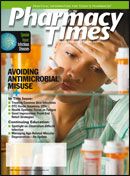News
Article
Pharmacy Times
February Health Systems Product News
Mozobil (plerixafor injection)

Genzyme Corp (Cambridge, MA) recently received FDAapproval to market Mozobil, a hematopoietic stem cell mobilizer.The drug is indicated in combination with granulocytecolonystimulating factor (G-CSF) to mobilize hematopoieticstem cells to the peripheral blood for collection and subsequentautologous transplantation in patients with non-Hodgkin'slymphoma and multiple myeloma. Clinicians should initiateMozobil treatment after the patient has received G-CSFonce daily for 4 days. The product should be administeredapproximately 11 hours prior to initiation of apheresis for upto 4 consecutive days. The recommended dose of Mozobil is0.24 mg/kg body weight by subcutaneous injection. If creatinineclearance is =50 mL/min, decrease dose by one third to0.16 mg/kg. Mozobil is supplied as a single-use vial containing1.2 mL of a 20-mg/mL solution. For more information, visitwww.mozobil.com, or call 877-4MOZOBIL.
RiaSTAP

CSL Behring's (King of Prussia, PA) RiaSTAP was recentlylicensed by the FDA. RiaSTAP, Fibrinogen Concentrate(Human) is indicated for the treatment of acute bleedingepisodes in patients with congenital fibrinogen deficiency,including afibrinogenemia and hypofibrinogenemia.Individuals with congenital fibrinogen are unable to makesufficient amounts of fibrinogen, which plays an importantrole in blood coagulation by helping to form blood clots andprevent bleeding. RiaSTAP dosing, duration of dosing, andfrequency of administration should be individualized basedon the extent of bleeding, laboratory values, and clinicalcondition of the patient. The product is available as a singleusevial containing 900 mg to 1300 mg lyophilized fibrinogenconcentrate powder for reconstitution with 50 mL of sterilewater for injection. For more information, visit www.riastap.com, or call 888-508-6978.
Rapid-Fill Automated Syringe Filler

Baxa Corp (Englewood, CO) recently announced the additionof colored syringe labels to its Rapid-Fill AutomatedSyringe Filler offering. The Rapid-Fill is accurate, easy-touse,safe, and efficient automation for intravenous syringefilling. The system reduces pharmacy overhead for batchingactivities, while providing the opportunity for more adequatestaff allocation and greater inventory control. The syringelabels are available in 8 new colors, in addition to the originalwhite, that allow health care professionals to extend theRapid-Fill Automated Syringe Filler automation to broaderapplications in pharmacy filling. The company has added 8color labels to its product line for use in anesthesia applications.The new labels expand the potential uses of the uniqueRapid-Fill product for hospital pharmacies by reducing theworkload involved in sterile filling and labeling of anestheticdrugs. For more information, visit www.baxa.com, or call800-567-BAXA (800-567-2292).
Identification Bands, Pens, and SurgicalSkin Markers

EPS Inc (Ivyland, PA) recently introduced a line of IdentificationBands, Pens, and Surgical Skin Markers to enhancemedication and patient identification. The IdentificationBands are available in both Mother/Infant and Mother/Father/Infant styles. The matching serial numbers ensurethat the infant and parents are properly correlated. The extrasoft plastic and nonirritating snap provides comfort for bothparents and children. The bands are available in 3-part and4-part styles in white, pink, or blue and are ideal for use withany identification band. The permanent ink is resistant towater, alcohol, and smears. The product is available in blue,green, red, and black and can be used to mark materials andsupplies throughout the hospital. The Surgical Skin Markersare available in both sterile and nonsterile styles. The sterilepens are packaged in plastic, in a peel-down, nonfiber sheddingpackage, specifically designed for use in sterile fields.Available with labels and rulers, all Surgical Skin Markersuse a nontoxic gentian violet ink. For more information, visitwww.medidose.com, or call 800-523-8966.







